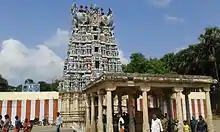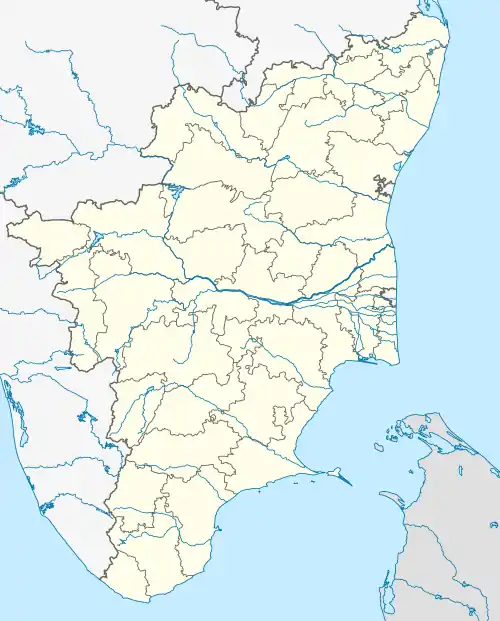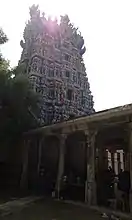ThiruVaragunamangai Perumal Temple
ThiruVaragunamangai Permual Temple (also called Vijayasana Perumal) is one of the Nava Tirupathi.,[1] nine Hindu temples dedicated to Lord Vishnu located in Tiruchendur-Tirunelveli route, Tamil Nadu, India in the banks of Thamiraparani river. All these 9 temples are classified as "Divya Desams", the 108 temples of Vishnu revered by the 12 poet saints, or Alwars.[2] The temple at Natham also known Chandran Sthalam, the 2nd of the Navathirupathis.[3] Constructed in the Dravidian style of architecture, the temple is dedicated to Vishnu who is worshipped as Vijayasana Perumal and Lakshmi as Varagunavalli.
| ThiruVaragunamangai Perumal Temple | |
|---|---|
 | |
| Religion | |
| Affiliation | Hinduism |
| District | Thoothukudi |
| Deity | |
| Features |
|
| Location | |
| Location | Natham |
| State | Tamil Nadu |
| Country | India |
 Location in Tamil Nadu | |
| Geographic coordinates | 8°38′13″N 77°55′26″E |
| Architecture | |
| Type | Dravidian architecture |
A granite wall surrounds the temple, enclosing all its shrines. The rajagopuram, the temple's gateway tower has five tiers. The temple follows Thenkalai tradition of worship. Six daily rituals and three yearly festivals are held at the temple, of which the ten-day annual Vaikanda Ekadasi during the Tamil month of Margazhi (December - January) and the Nammazhwar birth celebrations with Garudasevai with all nine temple of Navatirupathi, being the most prominent. The temple is maintained and administered by the Hindu Religious and Endowment Board of the Government of Tamil Nadu.
Legend
Varagunamangai, the one who granted his Dharshan to a Brahmin vedic scholar is referred to in one of the poems of Nammalwar, he must be posterior to Varaguna Pandya from whose name it is assumed Varagunamangai took its name. But there are number of instances where this logic is not pertinent.[4] The temple has a five-tiered rajagopuram amidst lush vegetation around the temple. Vishnu here appeared in answer to the prayer of sage Romesar who performed severe penances for several thousand years.[5][6]
As per another legend, a sage named Vedavith was living along the banks of the Tamarabarani river and was serving his elderly parents. After the death of his parents, he wanted to perform penance. Vishnu appeared in the form of a Brahmin and advised him to perform penance at Varagunamangai. After several years of penance and pleased by the devotion of Vedavith, Vishnu appeared before him. Vedavith requested Vishnu to appear as Vijaysanan at this place.[7]
Architecture
The temple is located in Tiruchendur-Tirunelveli route, Tamil Nadu, India in the banks of Thamiraparani river, in the South Indian state of Tamil Nadu. The temple is constructed in Dravidian style of architecture. All the shrines of the temple are enclosed in a rectangular granite structure, which is pierced by a five-tiered gopuram (gateway tower). There is a sixteen pillared granite hall in front of the gopuram. The sanctum houses the image of Vijayasana Perumal in sitting posture, flanked by both his consorts on either side. The festival images of Vijayasanar and Varagunavalli are located inside the sanctum.[8] The temple is maintained and administered by the Hindu Religious and Endowment Board of the Government of Tamil Nadu.[9]
Festival

The Garuda Sevai utsavam(festival) in the month of Vaikasi(May-Jun) witnesses 9 Garudasevai, a spectacular event in which festival image idols from the Nava Tirupathis shrines in the area are brought on Garuda vahana(sacred vehicle). An idol of Nammalvar is also brought here on an Anna Vahanam (palanquin) and his paasurams (verses) dedicated to each of these 9 temples are recited. The utsavar(festival deity) of Nammalvar is taken in a palanquin to each of the 9 temples, through the paddy fields in the area. The paasurams(poems) dedicated to each of the 9 Divyadesams are chanted in the respective shrines. This is the most important of the festivals in this area, and it draws thousands of visitors.[10][6]
The temple follows the traditions of the Thenkalai sect of Vaishnavite tradition and follows Pancharathra aagama. The temple priests perform the pooja (rituals) during festivals and on a daily basis. As at other Vishnu temples of Tamil Nadu, the priests belong to the Vaishnavaite community, a Brahmin sub-caste. The temple rituals are performed six times a day: Kalasanthi at 8:00 a.m., Uchikalam at 12:00 p.m., Sayarakshai at 6:00 p.m., and Ardha Jamam at 8:00 p.m. Each ritual has three steps: alangaram (decoration), neivethanam (food offering) and deepa aradanai (waving of lamps) for both Vijayasana Perumal and Varagunavalli. During the last step of worship, nagaswaram (pipe instrument) and tavil (percussion instrument) are played, religious instructions in the Vedas (sacred text) are recited by priests, and worshippers prostrate themselves in front of the temple mast. There are weekly, monthly and fortnightly rituals performed in the temple.[3]
Religious significance
Brahmanda Purana one of the eighteen sacred texts of Hinduism and written by Veda Vyasa contains a chapter called Navathirupathi Mahatmeeyam. Vaikunta Mahatmeeyam is another work in Sanskrit that glorifies the temple and is a part of Tamraparani Sthalapurana available only in palm manuscripts.[11] The temple is revered in Nalayira Divya Prabandham, the 7th–9th century Vaishnava canon, by Nammazhwar. The temple is classified as a Divyadesam, one of the 108 Vishnu temples that are mentioned in the book. The temple is also classified as a Navatirupathi, the nine temples revered by Nammazhwar located in the banks of Tamiraparani river. The temple is next only to Alwarthirunagari Temple in terms of importance among the nine Navatirupathi temple.[8][3] Nammazhwar makes a reference about the temple in his works in Thirvaimozhi. During the 18th and 19th centuries, the temple finds mention in several works like 108 Tirupathi Anthathi by Divya Kavi Pillai Perumal Aiyangar. The temple also forms a series of Navagraha temples where each of the nine planetary deities of one of the temples of Navatirupathi. The temple is associated with the planet Budha (Mercury).[12][8]
References
- Rajagopal, Gowri. Twelve Azhvars - Twelve saints of Sri Vaishnavism. Chennai: Sri Ramakrishna Math. pp. 71–76. ISBN 978-81-7883-592-1.
- Ramesh, M.S. (1993). 108 Vaishnavite Divya Desams volume one Divyadesams in Tondai Nadu. Tirpuati: Tirupati Tirumala Devastanams.
- "Sri Vijayanasa Perumal temple". Dinamalar. 2015. Retrieved 7 October 2018.
- Early history of Vaishnavism in south India.Sakkottai Krishnaswami Aiyangar. Page 53.
- Adinathar Alwar thirukkoil Sthala varalaru; Temple publication; Page 3
- Anantharaman, Ambujam (2006). Temples of South India. East West Books (Madras). pp. 33–43. ISBN 978-81-88661-42-8.
- A., Radha; Dr. G., Paranthaman (2020). "Dasavatharam and Navagrahas in Historical Perspective". Tamil Journal of Temple Studies. 1: 36.
- M., Rajagopalan (1993). 15 Vaishnava Temples of Tamil Nadu. Chennai, India: Govindaswamy Printers. pp. 155–159.
- "Thirukoil - Temple list of Tamil Nadu" (PDF). Hindu Religious & Charitable Endowments Department, Government of Tamil Nadu. p. 244.
- Suriya (2015). Jothirlingam: The Indian Temple Guide. Partridge Publishing. p. 30. ISBN 9781482847864.
- V., Meena. Temples in South India. Kanniyakumari: Harikumar Arts. pp. 8–9.
- "Amazing posture at Srivaikuntam". The Hindu. 15 November 2001. Archived from the original on 29 January 2003. Retrieved 25 October 2015.
External links
| Wikimedia Commons has media related to Varagunamangai temple. |